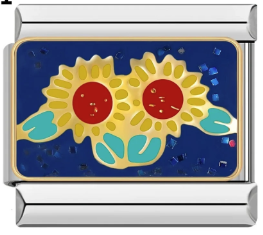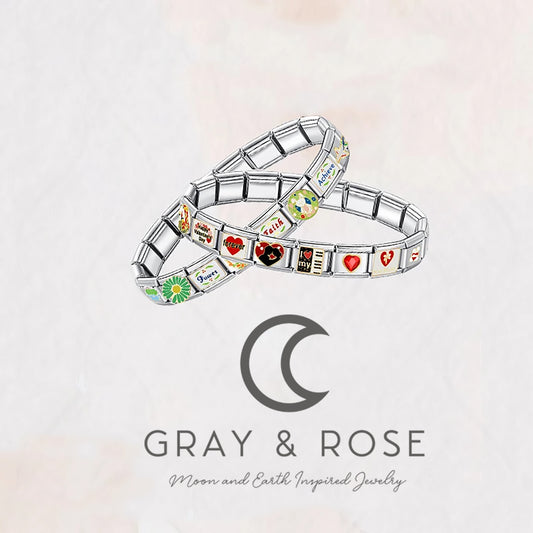Introduction: A Tale of Two Metals
When it comes to jewelry, the choice of metal is as crucial as the design itself. Sterling silver and stainless steel are two popular options, each boasting unique characteristics and aesthetic appeals. In this comprehensive guide, we'll embark on a journey to explore these two metals, dissecting their properties, uses, and reasons for their popularity in the jewelry world.
Understanding Sterling Silver
Sterling silver, an alloy composed of 92.5% silver and 7.5% other metals, typically copper, has been a symbol of luxury and sophistication for centuries. Its origins can be traced back to ancient times, and it continues to be a preferred choice for high-end jewelry and silverware.
The Allure of Sterling Silver
The allure of sterling silver lies in its lustrous sheen and malleability, which allows for intricate designs. It's celebrated for its classic elegance and has a significant presence in the realms of fine jewelry and heirloom pieces.
Stainless Steel: The Modern Contender
In contrast, stainless steel, an iron-based alloy mixed with chromium, nickel, and other elements, is a more recent invention. It emerged in the early 20th century and quickly gained popularity due to its durability and resistance to corrosion.
Why Choose Stainless Steel?
Stainless steel's strength and low maintenance make it an ideal choice for everyday wear. It's particularly favored in contemporary jewelry designs and for pieces that require enduring resilience.

Comparing Aesthetics and Design Flexibility
Both sterling silver and stainless steel have distinct visual appeals that cater to different tastes and styles.
Sterling Silver: Timeless Elegance
Sterling silver's bright, white metallic luster exudes a classic elegance. Its softness allows for elaborate designs, making it a favorite for artisan jewelers and those seeking traditional or vintage styles.
Crafting Complexities with Sterling Silver
The malleability of sterling silver, however, comes with a need for greater care. It's prone to scratches and tarnishing, requiring regular polishing to maintain its shine.
Stainless Steel: Sleek and Modern
Stainless steel, on the other hand, boasts a sleek, modern look. Its silvery-grey tone offers a more contemporary feel, suitable for minimalist and avant-garde designs.
Durability and Maintenance of Stainless Steel
The robustness of stainless steel means it's less likely to scratch or dent, making it a practical choice for everyday wear. It's also more resistant to tarnishing, requiring minimal maintenance.

Delving into Durability and Longevity
The longevity of your jewelry is a crucial factor to consider. Here, we compare how sterling silver and stainless steel stand the test of time.
Sterling Silver: Delicate yet Durable
While sterling silver is softer than stainless steel, with proper care, it can last for generations. It's not uncommon for sterling silver pieces to become cherished family heirlooms.
Caring for Sterling Silver
To preserve its beauty, sterling silver jewelry should be stored in airtight containers and cleaned regularly with appropriate silver cleaners.
Stainless Steel: Built to Last
Stainless steel's composition makes it highly resistant to corrosion and rust. This inherent durability means it can endure daily wear and tear with ease, retaining its appearance over time.
Low Maintenance, High Resilience
The low maintenance aspect of stainless steel is a significant advantage. It can withstand exposure to water and does not require frequent polishing.
This exploration into the world of sterling silver and stainless steel reveals the unique qualities and advantages of each metal. As we continue to delve deeper into their characteristics in the following sections, you'll gain a clearer understanding of which metal might be the best choice for your jewelry preferences.
In the next section, we'll investigate the practical considerations such as cost, hypoallergenic properties, and suitability for different types of jewelry, further guiding your decision in the battle of the metals. Stay tuned for more insightful comparisons and tips.
Practical Considerations: Cost, Comfort, and Suitability
Evaluating Cost: Affordability vs. Luxury
The price point is a significant factor when choosing between sterling silver and stainless steel. Understanding the cost implications can help in making an informed decision.
Sterling Silver: A Touch of Luxury
Sterling silver, being a precious metal, typically commands a higher price. Its value is influenced by the silver market, making it a more luxurious choice. The craftsmanship involved in creating sterling silver pieces also contributes to its cost.
Stainless Steel: The Affordable Alternative
In contrast, stainless steel is more affordable and provides excellent value for money. Its lower cost makes it accessible to a wider audience, appealing to those seeking stylish yet budget-friendly options.
Comfort and Hypoallergenic Properties
When it comes to jewelry, comfort is key. Both metals have unique attributes in terms of wearability and skin sensitivity.
Sterling Silver: Gentle on the Skin
Sterling silver is known for being hypoallergenic, making it a great choice for people with sensitive skin. Its lightweight nature adds to the comfort, making it suitable for prolonged wear.
Stainless Steel: Strength and Safety
Stainless steel is also hypoallergenic, thanks to its non-reactive nature. It's an ideal option for those with nickel allergies, as high-quality stainless steel used in jewelry typically doesn't contain nickel.
Suitability for Different Jewelry Types
Different types of jewelry can benefit from the specific properties of each metal.
Sterling Silver's Versatility
Sterling silver's versatility makes it suitable for a wide range of jewelry, from delicate necklaces to ornate rings. Its ability to be intricately worked makes it a favorite for custom designs and detailed patterns.
Stainless Steel's Robustness
Stainless steel, with its sturdy nature, is perfect for more utilitarian pieces like watches and bracelets. It's also a popular choice for modern, geometric designs and pieces that require a more substantial feel.

Maintenance and Longevity: Preserving Your Jewelry's Beauty
Proper care and maintenance are essential to prolong the life of your jewelry, regardless of the metal.
Caring for Sterling Silver
Sterling silver requires regular cleaning to prevent tarnish. It's advisable to use a silver polish cloth and avoid harsh chemicals. Storing sterling silver jewelry in a cool, dry place can also help in maintaining its luster.
Tackling Tarnish: Keeping Sterling Silver Shiny
Over time, sterling silver can develop a patina, which some people appreciate for its antique look. However, if you prefer to keep your silver shiny, regular polishing is necessary.
Stainless Steel: Ease of Care
Stainless steel is much easier to maintain. It can be cleaned with mild soap and water and is resistant to tarnishing and rust. This low-maintenance aspect makes it a practical choice for everyday jewelry.
Durability for Daily Wear
The toughness of stainless steel ensures that it can withstand the rigors of daily life without losing its aesthetic appeal. This resilience is a key factor in its growing popularity in the jewelry market.
In this section, we've covered the practical aspects of choosing between sterling silver and stainless steel, including cost considerations, comfort, suitability for different jewelry types, and maintenance needs. These factors play a crucial role in determining the right metal for your personal style and lifestyle.
In the final section, we'll explore the environmental impact and sustainability of both metals, delve into their historical and cultural significance, and provide tips on how to make the best choice for your needs. Stay tuned for these final insights in the battle of the metals.
Environmental Impact and Sustainability: Making Conscious Choices
Sterling Silver: Recycling and Sustainability
Sterling silver, as a precious metal, often comes from mining, which can have environmental impacts. However, the silver industry has made strides in recycling, significantly reducing the need for mining. Sterling silver jewelry often contains a high percentage of recycled material, making it a more sustainable choice for environmentally conscious consumers.
The Green Choice: Eco-Friendly Silver
Choosing sterling silver can be seen as an eco-friendly option, especially when sourced from manufacturers committed to sustainable practices. The recyclability of silver ensures that your jewelry choice has a lower environmental footprint.
Stainless Steel: Durability and Recycling
Stainless steel is also highly recyclable, which adds to its environmental appeal. Its durability means that products made from stainless steel have long lifespans, reducing the need for frequent replacement and, consequently, less environmental strain.
The Strength of Sustainability
The robustness of stainless steel not only makes it a practical choice for jewelry but also a sustainable one, as its longevity and recyclability contribute positively to environmental conservation efforts.
Historical and Cultural Significance: Beyond the Metal
Both sterling silver and stainless steel have rich histories and cultural significances that add depth to their appeal.
Sterling Silver's Rich Heritage
Sterling silver has been used for centuries, dating back to ancient civilizations. It has a storied history in various cultures, often associated with wealth, prestige, and artistic expression. This cultural heritage adds an element of timelessness and intrinsic value to sterling silver jewelry.
Celebrating Traditions with Silver
Owning sterling silver jewelry can feel like owning a piece of history, with its use in traditional ceremonies and heirloom pieces. It connects the wearer not only to the beauty of the metal but also to the stories and traditions it represents.
Stainless Steel: The Modern Marvel
While stainless steel doesn't have as long a history as sterling silver, it has quickly established its place in the modern world. Its invention in the early 20th century marked a significant technological advancement, and it has since become a symbol of modernity and innovation.
Embracing Contemporary Culture
Stainless steel's contemporary appeal resonates with those who appreciate modern design and technology. Its use in modern architecture, medical devices, and, of course, jewelry, speaks to its versatility and modern aesthetic.
Making the Right Choice: Personal Preferences and Lifestyle
In the battle of the metals, the right choice depends on your personal preferences, lifestyle, and values. Here are some final tips to help you decide:
- Consider Your Lifestyle: If you lead an active lifestyle or need low-maintenance jewelry, stainless steel might be the better choice. For those who prefer luxury and are willing to invest in care, sterling silver is ideal.
- Reflect on Your Style: Do you lean towards classic elegance or modern minimalism? Your personal style should guide your choice between the timeless beauty of sterling silver and the sleek, contemporary look of stainless steel.
- Think About Sustainability: If environmental impact is important to you, consider the recyclability and sustainability practices behind the metal you choose.
- Remember the Occasion: For special occasions or heirloom pieces, sterling silver offers a sense of tradition and luxury. Stainless steel is excellent for everyday wear and modern designs.
In conclusion, whether you choose sterling silver or stainless steel, your decision reflects not only your aesthetic preferences but also your lifestyle, values, and the story you wish to tell with your jewelry. Each metal offers its unique beauty and qualities, making them both worthy contenders in the world of jewelry.




















